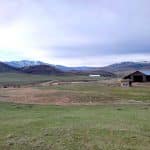School district advances 22-unit housing project on Sleeping Giant parcel; eyes sale of Whistler property

John F. Russell/Steamboat Pilot & Today
The Steamboat Springs School District took a significant step forward on two housing fronts last week: moving toward a 22-unit affordable workforce housing project at its Sleeping Giant parcel and opening the door to selling its Whistler Park property, potentially to the city for parkland.
At the Aug. 11 school board business meeting, Superintendent Celine Wicks outlined the district’s strategy to directly address staff housing shortages while also clarifying the future of landholdings that have long drawn community attention.
“We have gotten a lot of work done on the affordable housing front,” said Wicks of progress made over the summer. “We are definitely going to be focused on our Sleeping Giant Parcel to work on affordable housing…we’re recommending to the board that we do sell that (Whistler) parcel.”
Selling the Whistler property
The 9.2-acre Whistler parcel has been a recurring discussion for the district, with previous efforts to develop the land into either housing or school infrastructure meeting stiff community resistance. Wicks said the district plans to obtain a new appraisal in September, which will inform potential negotiations with the city.
While board members expressed strong support for selling the property, they emphasized the need to secure a “top market price,” given that proceeds would ideally be reinvested in staff housing.
“Obviously, the top choice for the community is going to be if we can work with the city and keep it as a park and open space for that area,” said Board President Katy Lee, “but I do feel very strongly that we need to make sure that we get adequate value out of it for the purpose of housing our staff.”
During the public comment period, Steamboat Springs Parks and Recreation Director Angela Cosby thanked the district for seeking a solution that she hopes “can benefit both the school district and the city.”
Community member Kathy Connell, who also represents Steamboat Digs Dogs, praised the spirit of cooperation.
“Whether it’s for our teachers, our communities, parks and recreation, we’re always trying to look at the greater good,” Connell said.
Plans for 22 affordable units

Turning to the Sleeping Giant neighborhood, Wicks detailed the next phase of an effort to create workforce housing on the district-owned parcel.
After issuing a request for proposals earlier this year, a nine-member committee — comprising district leaders, board members and neighborhood representation — selected Rural Homes, a nonprofit developer led by Paul Major, said Wicks.
The proposed project would cost approximately $10 million, Wicks explained, with 22 townhome-style units spread across 2.5 acres. Of those, the school district would purchase 10 units for staff housing, while 12 would be offered for sale to the broader community.
“This is not apartments — it’s townhouses that would look like they kind of fit into the neighborhood,” said Wicks, who added that unit sizes could range from one to four bedrooms.
Early interest has been strong. The end-of-year staff survey recorded 89 district employees eager to purchase a home, far outpacing the available supply.
Recognizing that demand, the district plans to adopt a “waterfall” system for access, prioritizing district employees but also including other essential community workers such as police, firefighters, health care staff, Colorado Mountain College employees and Winter Sports Club coaches.
The district is not pursuing state Proposition 123 dollars for the project, which Wicks said would have capped eligibility at 100% of Area Median Income, excluding many staff members the project aims to serve.
Instead, the district will fund roughly half the cost, or $5 million, for its 10 units, while Rural Homes will finance the for-sale inventory.
Hurdles and next steps
Despite momentum, the project’s biggest obstacle may come in the form of infrastructure. The Sleeping Giant parcel does not currently have water service, though it could connect through existing lines with cooperation from the city and the local water district.
Board member Kevin Callahan, who lives near the site, flagged the issue as the first likely concern from neighbors.
“If we cannot get water, this project will not get off the ground,” Wicks acknowledged, calling it the project’s “first hurdle” before entitlements can proceed.
Board members expressed unanimous support for moving forward with the planning and engineering work necessary.
“We’re just trying to make this a win-win for our staff and for the community,” said Wicks, who plans to visit similar Rural Homes projects in Ouray and nearby areas in the fall to inform the Steamboat project.

Support Local Journalism

Support Local Journalism
Readers around Steamboat and Routt County make the Steamboat Pilot & Today’s work possible. Your financial contribution supports our efforts to deliver quality, locally relevant journalism.
Now more than ever, your support is critical to help us keep our community informed about the evolving coronavirus pandemic and the impact it is having locally. Every contribution, however large or small, will make a difference.
Each donation will be used exclusively for the development and creation of increased news coverage.










